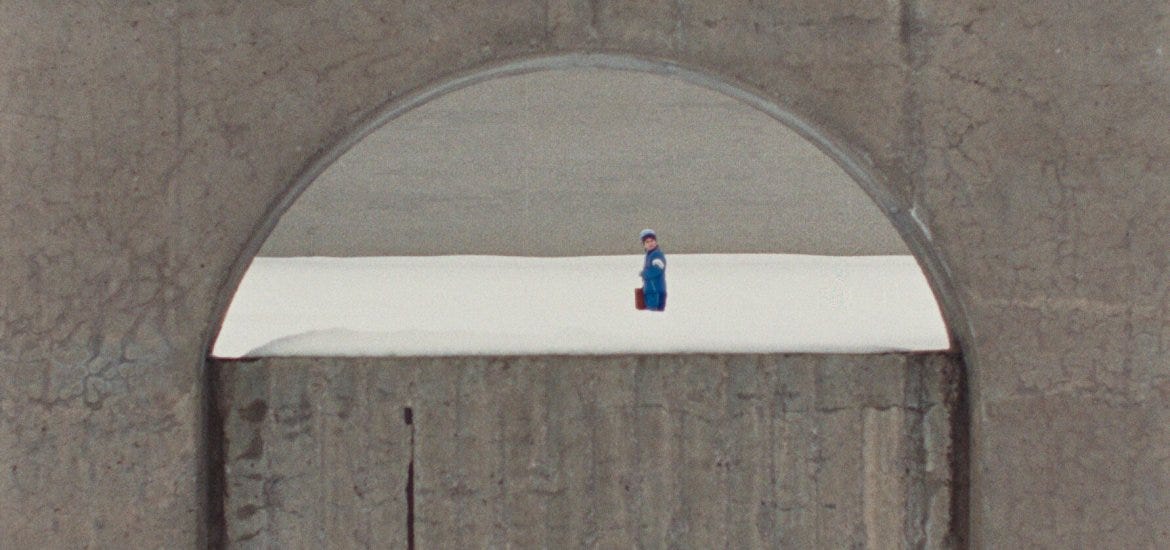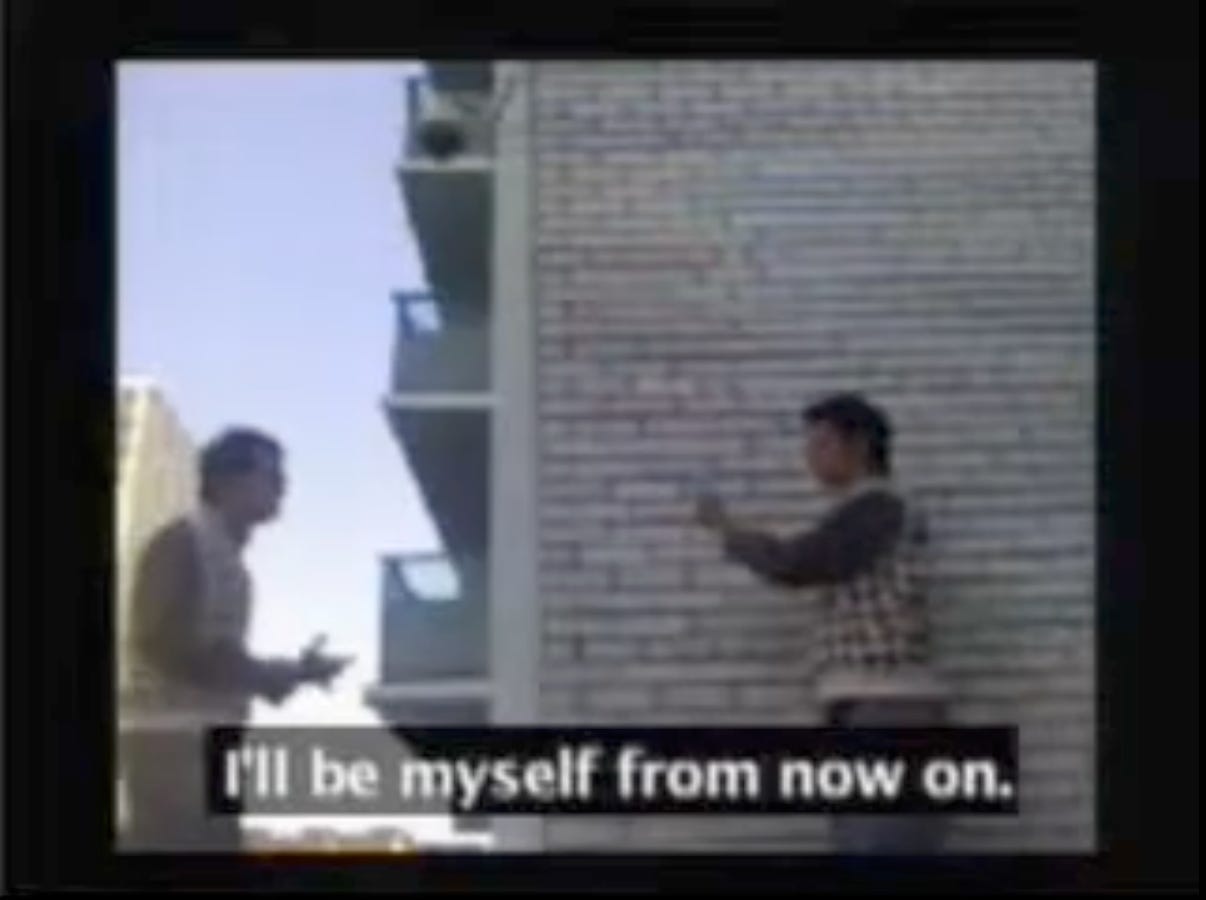everybody's winnipeg
universal language, kiarostami's koker trilogy, and the glory of crappy northern cities
My goal with this newsletter is to write about new films as they reach general release, plus some seasonally appropriate commentary on other cinematic events and interests. This week we’ve got Matthew Rankin’s Universal Language, a film that debuted at Cannes last year, finally got into US theaters in February, and made it to Minnesota for one glorious week. My greatest hope right now is that I’ll get it together enough to put these out every Wednesday so that in the future you might actually get to see the movie I’m writing about.

Here's a story that might have happened to me, but maybe not.1 At the end of my senior year of high school our class rented out a riverboat on the Mississippi. Late in the night I was leaning against the railing with a friend who had never left Minnesota and a Norwegian exchange-student who was about to leave forever. We watched the skyscrapers of downtown St. Paul rise above the riverbanks, the lights sprinkling over our faces as we gazed in quiet awe at the spires and the brick and the blinking 1st National Bank sign. “Isn't St. Paul the most beautiful city in the world?” my friend said.
Our Norwegian exchange student shook her head. “No,” she said, “it's not.”
The love I felt for my city that night will never leave me, even if this story is made up. The adoration and the undercutting: the knowledge that our ugly Northern city has so little to offer, that only people as pathetic as us could ever appreciate the glory of our inconsequential architecture. It’s the love that Steve Coogan’s Tony Wilson feels as he gazes over Manchester at the end of 24 Hour Party People, and it's the love that Matthew Rankin, shooting from a freeway underpass, has for his native Winnipeg in Universal Language.
Universal Language, Rankin’s second feature, centers on a government bureaucrat, Matthew Rankin (played by Matthew Rankin), who returns to Winnipeg to visit his ailing mother, only to discover that she no longer lives at her house. Meanwhile, two brave schoolchildren try to recover their classmates's lost glasses; their greatest hope is that they can free a banknote from an ice puddle and buy him a new pair. They're aided in this quest by an untrustworthy tour guide with a vested interested in Rankin's return. There are also a lot of side plots involving turkeys.
Our guide through Rankin’s Winnipeg is Massoud, the aforementioned tour guide. Deadpan but verbally enthusiastic, he leads us through the sights: a bus bench featuring a forgotten briefcase (apparently a UNESCO heritage site), an empty mall fountain that no longer takes wishes, and, most lovingly of all, a geometric pattern of reddish and brown bricks against beige bricks on the side of an apartment building that he calls a "fresco." There's no conceit that any of this is any good: our audience-surrogate tour group is resoundingly unimpressed.2
This is Rankin’s Winnipeg in all its budget-brutalist glory. But there’s a twist: everybody in Manitoba speaks Farsi. If you already sort of get it then this movie is probably going to work for you. The joke, if that's the right word, is that Universal Language is filmed in the style of 1980s-90s Iranian meta-cinema. It leans most heavily on the films of Abbas Kiarostami, most particularly 1987’s Where is the Friend’s House?, which Universal Language follows so closely that you could almost call it a parody.
The parallels and references are dense. One of the loveliest is Rankin’s re-interpretation of a man from Where is the Friend’s House? who carries a pile of cedar branches; in Winnipeg, he’s transformed into a walking Christmas tree. Bits like this make up most of Rankin's film, a constant onslaught of Winnipeg realtor ads done up like Iranian propaganda, Tim Horton’s tea houses, and turkey salesmen who quote Hafiz and The Guess Who in equal measure.
The off-the-wall deadpan can get exhausting, and by the time the woman hawking a paper-shredder turns up in a snowstorm, you might be tapped out. After an hour of chuckling I was forced to ask myself if I was only willing to forgive the reference-heaviness of this movie because I like the references it makes. Is this fan-service for Iranian meta-cinema? Do I only like this because it makes me feel smart to be in on the joke?
Maybe. But a few days out and I’m more and and more convinced there’s something here. The contrivance is by design; the artifice of Rankin’s cinema is deliberately impossible to ignore3. The architectural shots are Winnipeg, but most of the action is filmed in Montreal. Snow is heavily featured, but the film was shot in summer.4 The rules of cinematography are regularly broken, sometimes in Iranian ways (drifting off from the action to explore side subjects, dwelling on the exteriors of building instead of their interiors) but sometimes in deliberately alienating ways - most effectively, a sequence of 180 smash cuts that Rankin seems to have included to intentionally bother film professors. And of course, everyone other than Rankin is played by actors. Not only actors, but Iranian actors speaking Farsi, a language spoken by .19% of the Winnipeg population.
In short, Rankin has made it impossible to accept his film as verisimilitude - and he’s done that by appropriating a cinematic style that is most celebrated for its documentarian naturalism. Where is the Friend's House? looks and sounds the way it does because it was filmed on a small budget in rural Iran, peopled by non-actors who often didn't realize they were in a fictional film. Rankin does the opposite, pushing his film's artifice to the point that the written characters don't seem to be aware that there's such a thing as real life.
Rankin isn’t the first person to mess with the reality of Where is the Friend’s House?; Kiarostami did it too. In 1992’s And Life Goes On, a director (played by an actor) returns to the village of Koker to check in on the main actors/characters of Where is the Friend’s House? after a devastating earthquake. The characters he meets make reference to the original movie (and, in a couple moments, the one they’re currently in). Kiarostami takes this even further in Through the Olive Trees (1994), a movie about the making of And Life Goes On that undercuts the premises of the previous two films and features a director played by a different actor who directs the first actor who played him. Each film pushes the viewer further away from a belief in verisimilitude and deeper into the mentality of the director, the action on screen getting truer to life just as the audience’s belief in what’s happening gets ground to a pulp.
If Kiarostami brings the viewer to the director, Rankin does the opposite, exposing the director as just another viewer. Universal Language reveals Rankin as a Kiarostami fan whose viewing of the Koker trilogy has altered his perception of his own lived experience. He plays himself, acting out events from his own life in his native surroundings, but transformed into Kiarostami’s cinematographic language - a language Kiarostami himself has already exposed as artifice. In other words, we’re watching the impossibility of an unmediated experience, an explicit exposure of cinema’s capacity to transform the way we experience even the most intimate components of our lives.
In this context, morphing a very not-Iranian place like Winnipeg into the Iran of Where is the Friend's House? isn’t an act of arch cuteness but a deliberate continuation of the Koker trilogy’s meta-exploration. When a transformation occurs at the climax of the film - when all the contrived little stories come together in one living room, and something stunning happens to the alienated director/character whose vision guides the film he’s participating in - it all clicks. Of course it’s contrived. If it wasn’t, it wouldn’t exist.

All of this could be real head-up-your-ass stuff, and I'll admit that it might be more fun to think about than it is to watch. But Rankin’s Winnipeg made me turn to my own city, one that I love with my own eyes but that I'm constantly seeing through the eyes of someone else. When will I see St. Paul as nothing but St. Paul - not in comparison to other cities, not in comparison to what it could be someday, not how it could be mythologized in film or in fiction - just simply as itself? We transform the world we occupy through the stories that occupy us. If your stories are fiction, you live in fiction. If your stories are film, you live in film. If your films are Kiarostami films, your city becomes a Kiarostami city, even if it's as far from Koker as Winnipeg is from Tehran.
There's a deep alienation you might experience in that, but Rankin isn't interested in exploring it. Instead he asks us to celebrate the wonders of universality, a celebration that shows up in pun, in reference, in meta-fiction, in re-interpretation. It’s a universal that’s revealed, rather than covered, by artifice. There's a reason that the emotional center of this film is a hug - a hug outside a Persian Tim Horton’s, held too long between two characters who barely know each other, clinging to one another in a moment of contrived, nonsensical connection.
This gets me back to my St. Paul skyline conversation. The more I write, the less I'm confident I was part of it, if it even happened at all. But it doesn't matter. I can still see that skyline as two people from opposite ends of the world could see it, and I can see it at the moment their opposing views transformed one another’s experience. It's all the same, none of it exactly real but nevertheless shared - humans encountering humans, creating and recreating their cities, all of us engaged in the simultaneously and not always truthful work of being alive.
Thanks for reading this week’s installment of life is disappointing. If you found this review slightly less disappointing than the rest of your life, consider liking, commenting, I guess pledging me money, or (probably most usefully to everyone involved) subscribing. Subscribing will get you exactly what you get here but sent to your email inbox. You can even send it to your spam. See you next week for some thoughts on Mickey 17 and Steven Soderbergh’s Black Bag.
I’ve listened to and retold the same stories featuring the same people so many times that I’ve lost track of what happened to me, what happened to my friends, and what someone (maybe me) just made up. I’m sure this isn’t a unique experience, and I think it’s relevant to this review.
If you love a city like Winnipeg and you're lucky enough to have roped in a visitor, this probably feels familiar. How many times have I driven down University Avenue in St. Paul, pointing out the important sights to visiting friends while they nod their head in forced amusement? There's the lone pop machine that still sells $1 Surge, the former location of the “book landfill,” the Cretin Cross where you could theoretically cut from an entrance ramp across 3 lanes directly to an exit ramp - and of course, the Spruce Tree Centre, perhaps the most beloved piece of architecture in all the Twin Cities. In Minnesota our particular brand of oppression effects even our guests, who are forced to smile and say things like, "OK!" and "Nice!"
Winnipeg is a global leader in the production of Christmas movies; Rankin says that 3,000 have been made there, almost all of them featuring fake snow.








